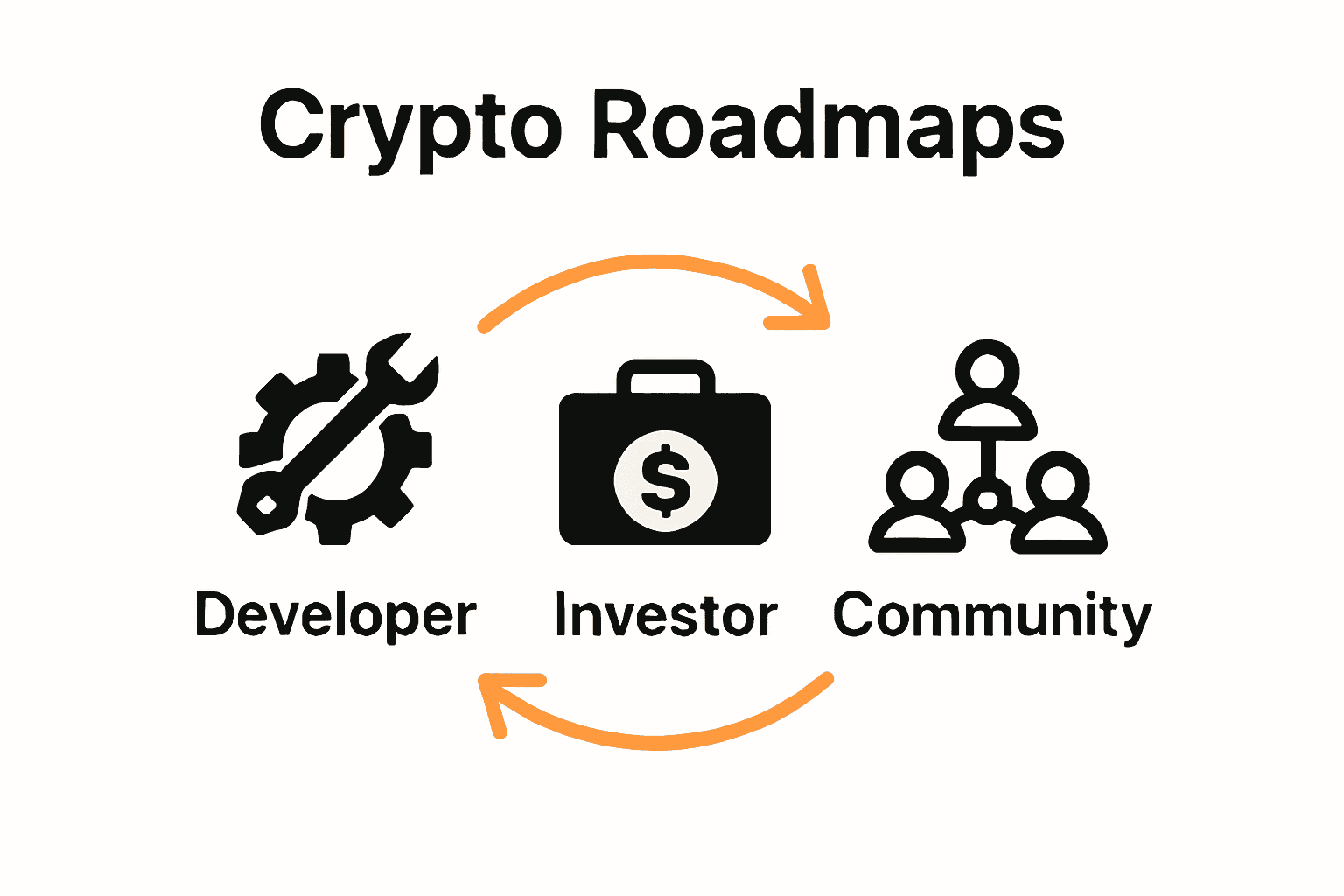What Is the Crypto Roadmap? Complete Guide

Nearly every successful cryptocurrency project starts by mapping out a clear path forward, but only a fraction deliver on their promises. In a world where billions of dollars change hands daily on crypto markets, understanding how a crypto roadmap shapes project direction is critical. A well-crafted roadmap is more than a fancy timeline—it reveals ambition, transparency, and commitment. This guide highlights what makes these blueprints essential and what you should look for when evaluating any blockchain venture.
Table of Contents
- Defining The Crypto Roadmap And Its Purpose
- Key Phases In A Cryptocurrency Roadmap
- Major Stakeholders And Their Roles
- Benefits And Challenges For Investors
- Common Pitfalls And What To Avoid
Key Takeaways
| Point | Details |
|---|---|
| Importance of a Crypto Roadmap | A crypto roadmap serves as a strategic blueprint outlining development phases, goals, and timelines, enhancing transparency and trust in the ecosystem. |
| Stakeholder Engagement | Active participation and clear communication among developers, investors, and community members are crucial for project success and adaptability. |
| Investment Considerations | Investors should conduct thorough due diligence, balancing potential rewards with risks such as market volatility and regulatory challenges. |
| Avoiding Common Pitfalls | Projects must maintain realistic milestones and clear objectives while being adaptable to avoid critical developmental mistakes and ensure long-term sustainability. |
Defining the Crypto Roadmap and Its Purpose
A crypto roadmap is a strategic blueprint that outlines the comprehensive development trajectory of a cryptocurrency or blockchain project. According to crypto.st, a roadmap represents a crucial visual representation detailing planned milestones, development goals, and expected progress over a specific timeline. This strategic document serves as a critical communication tool for stakeholders, including developers, investors, and the broader community.
The primary purpose of a crypto roadmap extends beyond simple project planning. It functions as a transparency mechanism that builds trust and alignment within the cryptocurrency ecosystem. En.wikipedia.org describes roadmaps as flexible planning schedules that support long-range strategic objectives by connecting short-term actions with long-term technological vision. For cryptocurrency projects, this means creating a clear narrative about technological evolution, feature development, and ecosystem growth.
Key components of an effective crypto roadmap typically include:
- Detailed technological development phases
- Planned smart contract upgrades
- Network infrastructure improvements
- Token economics adjustments
- Community engagement initiatives
- Security and compliance milestones
Successful roadmaps are not static documents but dynamic frameworks that adapt to technological advancements, market conditions, and community feedback. They provide stakeholders with a comprehensive understanding of a project’s potential trajectory while maintaining flexibility for innovative pivots and strategic refinements.
 Risk Disclosure Guide highlights that transparent and well-structured roadmaps are essential for managing investor expectations and demonstrating a project’s commitment to sustained development and value creation.
Risk Disclosure Guide highlights that transparent and well-structured roadmaps are essential for managing investor expectations and demonstrating a project’s commitment to sustained development and value creation.
Key Phases in a Cryptocurrency Roadmap
Cryptocurrency roadmaps typically unfold through strategic development phases that systematically transform a project from conceptual design to functional ecosystem. According to teachertoken56, these roadmaps generally encompass four critical stages: token development, initial fundraising, platform expansion, and sustained growth. Each phase represents a deliberate progression toward broader technological and community objectives.
The initial phases of a cryptocurrency roadmap are typically focused on foundational development and community engagement. As mailcoin.org illustrates through their comprehensive seven-phase approach, successful projects prioritize critical early steps such as:
- Publishing a detailed whitepaper
- Completing academic and technical reviews
- Developing open-source protocols
- Launching official project websites
- Implementing fair token distribution mechanisms
Later roadmap phases transition toward more complex technological and market integration goals. These advanced stages often include critical milestones like mainnet launches, smart contract deployments, enterprise integrations, and ecosystem expansion strategies. About Bitcoin XAI demonstrates how roadmaps serve as dynamic blueprints that balance technical innovation with strategic market positioning, allowing cryptocurrency projects to adapt and evolve in a rapidly changing technological landscape.
Ultimately, a well-constructed roadmap is more than a static document. It represents a living strategy that communicates a project’s vision, technical capabilities, and commitment to long-term development. By providing clear, transparent phases of growth, cryptocurrency projects can build investor confidence, attract developer talent, and create a compelling narrative of technological progress and potential.
Major Stakeholders and Their Roles
In the complex ecosystem of cryptocurrency development, major stakeholders play critical, interconnected roles that collectively drive a project’s success. Chain Insights emphasizes the importance of transparent communication and clear documentation to ensure all participants understand their responsibilities and the project’s overall objectives.
The primary stakeholders in a cryptocurrency project typically include:
- Developers: Technical architects who design and implement blockchain infrastructure
- Investors: Financial supporters providing capital and resources
- Community Members: Active participants who provide feedback and support adoption
- Token Holders: Individuals with financial and governance stakes in the project
- Advisors: Technical and strategic experts guiding project development
Each stakeholder group brings unique capabilities and expectations to the cryptocurrency ecosystem.
 Developers focus on technological innovation, creating robust smart contracts and improving network performance. Investors evaluate potential returns and technological viability, providing crucial funding for ongoing development. Bitcoin XAI Whitepaper demonstrates how strategic alignment between these stakeholders can create a powerful collaborative environment that drives technological advancement and market adoption.
Developers focus on technological innovation, creating robust smart contracts and improving network performance. Investors evaluate potential returns and technological viability, providing crucial funding for ongoing development. Bitcoin XAI Whitepaper demonstrates how strategic alignment between these stakeholders can create a powerful collaborative environment that drives technological advancement and market adoption.
Successful cryptocurrency projects recognize that stakeholder engagement is not a one-time event but an ongoing process. By maintaining transparent communication, delivering on roadmap promises, and creating mechanisms for meaningful participation, projects can build trust, attract talent, and create sustainable, community-driven ecosystems that can adapt to rapidly changing technological landscapes.
Benefits and Challenges for Investors
Investing in cryptocurrency projects requires a nuanced understanding of the potential rewards and risks inherent in emerging blockchain technologies. Risk Disclosure Guide highlights the critical importance of comprehensive due diligence before committing financial resources to any cryptocurrency venture.
Key benefits for cryptocurrency investors include:
- Potential for high returns compared to traditional investments
- Direct participation in innovative technological ecosystems
- Opportunities for early-stage token acquisitions
- Reduced transaction costs and increased financial autonomy
- Potential for governance rights through token ownership
- Exposure to cutting-edge blockchain technologies
However, investors must also navigate significant challenges such as market volatility, regulatory uncertainties, and technological complexities. Bitcoin XAI Whitepaper emphasizes the importance of understanding the underlying technological infrastructure and long-term vision of any cryptocurrency project before making investment decisions.
Successful cryptocurrency investment strategies demand a balanced approach that combines thorough research, risk management, and a long-term perspective. Investors should diversify their portfolio, stay informed about technological developments, and maintain realistic expectations about potential returns. The most sophisticated investors view cryptocurrency not just as a speculative asset, but as a transformative technology with potential to reshape financial systems and create new economic opportunities.
Common Pitfalls and What to Avoid
Navigating the cryptocurrency roadmap landscape requires a strategic approach to avoid critical developmental mistakes that can derail project success. TokenMinds emphasizes that one of the most fundamental pitfalls is the lack of clear, actionable planning steps that demonstrate consistent progress and value creation.
Common roadmap pitfalls for cryptocurrency projects include:
- Unrealistic milestone timelines
- Vague technological objectives
- Insufficient technical documentation
- Poor communication with community stakeholders
- Lack of adaptability in project strategy
- Overambitious feature promises
- Inadequate risk management protocols
Investors and project teams must be vigilant about potential red flags that signal potential project instability. Risk Disclosure Guide recommends conducting thorough due diligence, which includes examining the project’s technical whitepaper, evaluating the development team’s credentials, and assessing the clarity of their strategic roadmap. Transparency becomes a critical indicator of a project’s potential for long-term success.
Successful cryptocurrency projects distinguish themselves by maintaining realistic expectations, providing regular updates, and demonstrating a flexible yet focused approach to technological development. The most resilient roadmaps balance ambitious vision with pragmatic execution, allowing for strategic pivots while maintaining core technological objectives. Potential investors should view a roadmap not as a rigid contract, but as a dynamic blueprint that reflects the project’s ability to innovate and adapt in a rapidly evolving technological ecosystem.
Secure Your Place in the Future of Cryptocurrency with a Clear Roadmap
Understanding the critical role a crypto roadmap plays in navigating the complexities of blockchain development and investor trust is essential for anyone looking to enter the crypto market. The challenges of vague objectives, unrealistic milestones, and lack of transparency can leave investors uncertain and hesitant. If you want to be part of a project that embraces clear phases, transparent communication, and tangible technological progress, you need to act now.

Discover how Bitcoin XAI (BTCX), the world’s first sentient cryptocurrency, offers a uniquely structured prelaunch journey aligned with proven crypto roadmap principles. With record-breaking prelaunch success and secure purchase options using USDC, BTCX invites you to invest early and benefit from bonus incentives and referral rewards. Explore the detailed Bitcoin XAI Whitepaper and learn more about this innovative cryptocurrency that combines advanced technology with a transparent developmental vision. Visit https://btcxai.net today and secure your access to a cutting-edge investment opportunity before the official launch on January 1, 2026.
Frequently Asked Questions
What is a crypto roadmap?
A crypto roadmap is a strategic blueprint that outlines the development trajectory of a cryptocurrency or blockchain project, detailing planned milestones, development goals, and expected progress over time.
What are the key components of an effective crypto roadmap?
Key components typically include technological development phases, planned smart contract upgrades, network infrastructure improvements, token economics adjustments, community engagement initiatives, and security milestones.
What phases does a cryptocurrency roadmap typically include?
Cryptocurrency roadmaps generally include phases such as token development, initial fundraising, platform expansion, and sustained growth, each representing a deliberate progression toward broader goals.
Why is stakeholder engagement important in a cryptocurrency project?
Stakeholder engagement ensures transparency, builds trust, and aligns the interests of developers, investors, community members, and token holders, contributing to the project’s overall success.